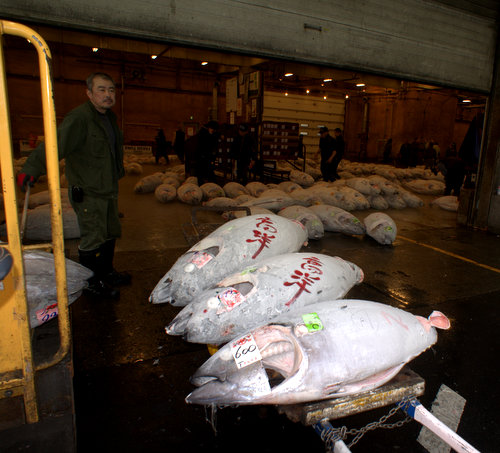Tsukiji Fish Story

It’s 3 a.m. and every nerve in my body wants to stay in bed but quickly the intellect clears enough to remind me that the world’s largest fish market is springing to life just a few blocks away and I’ve been invited to witness the structured chaos within its gates.
Tokyo hosts the market on the edge of the Ginza district. It opens to visitors around 4:30 a.m. most mornings except holidays and Sundays. The number of public visitors allowed in is restricted to around 120 each day and a queue lines up outside the main north gate waiting for permission to enter. I've been fortunate enough to accompany a licensed seafood processor and his party. Safety is always a concern and distraction another. The market is crowded with a furious intensity as rushing carts, hand and motorized, careen through narrow passageways between boxes and pallets, down alleys and through the warehouses. Each is on a singular mission – to deliver the freshest seafood to customers, restaurants and wholesalers across the crowded island.
On this particular morning, I’m joining a fishmonger from California’s Catalina Offshore Products, who is here to meet clients and observe the auction of sea urchins. At 5 a.m., brokers crowd bleachers in front of a handful of shouting auctioneers and make their purchases. They've already carefully inspected a roomful of boxes of sea urchin ‘tongues’ shipped in from around the world. On this particular day, the collection is drawn from waters in Russia, Chile, China, Canada, Japan and California. In less than a half hour, five to ten thousand trays of prepared sea urchin or Uni is sold. Fresh Uni is a delicacy and Japan consumes the most in the world.
The Uni exchange at Tsujkui concludes quickly and we head out to the main marketplace to look over other fish. There are bright red octopus coiled in blue packaging, a warehouse full of prized Tuna frozen solid and boxes of live fish sit in long trenches with salt water continuously pumped through. As seafood is the main staple of Japanese diets, most everything edible from the sea is available every day that the market is open. It’s staggering how much of it ships in and out in just a few hours. It’s also exhausting to witness, so by 8 a.m. our small party heads out to find breakfast and warm up after walking the cool expanses of the machine that is Tsukiji Market.
Pictures by the author, Elaine J. Masters

0 comments